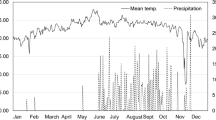Abstract
Specialised phytophagous arthropods often display high levels ofspecificity to particular sites on their host plant. In this paper we examinethe occupation of microhabitats and aggregation patterns of the eriophyoidmite,Acalitus essigi (Hassan), on its host plant, Europeanblackberry (Rubus fruticosus L. aggregate), a plant thatundergoes significant seasonal changes in its morphology. A.essigi was found to be a refuge inhabiting species. It resided inbudand leaf axil microhabitats on both primocanes and fructocanes and alsooccupiedberry and bract microhabitats on fructocanes. Population fluctuations withinthedifferent microhabitats were evident across seasons. From summer to winter,populations significantly declined in bract and leaf axil microhabitats, butsignificantly increased within bud microhabitats where overwintering took placeas slowly reproducing colonies. Live fruit and young shoots were alsoidentifiedas overwintering sites. A. essigi populations displayed anaggregated distribution both within and between individual blackberry canes.Within primocanes A. essigi were aggregated in the lower20% of cane length. On fructocanes aggregation of A.essigiwas in the lower 20% and especially in the upper 20% of cane length. In springA. essigi was confirmed to emerge from bud overwinteringsites and colonise shoots mainly in the lower third of the previousseason's primocanes, suggesting limited dispersal away from overwinteringsites. It is proposed that biotic factors such as tissue age, microhabitatmorphology and limited ambulatory dispersal capabilities are responsible fortheaggregation patterns of this mite.
Similar content being viewed by others

References
Bernays E.A. and Chapman R.F. 1994. Host-Plant Selection by Phytophagous Insects. Chapman & Hall, New York.
Burgess J.E. and Thompson M.M. 1985. Shoot development and bud mite infestation in hazelnut. Ann. Appl. Biol. 107: 397-408.
Curtis W.M. and Morris D.I. 1975. The Students Flora of Tasmania-part 1. 2nd edn. Government Printer, Tasmania.
de Lillo E. and Duso C. 1996. Currants and berries. In: Lindquist E.E., Sabelis M.W. and Bruin J. (eds), Eriophyoid Mites-their Biology, Natural Enemies and Control. Elsevier Science, Amsterdam, pp. 583-592.
Harvey T.L. and Martin T.J. 1988. Sticky tape method to measure cultivar effect on wheat curl mite populations in wheat spikes. J. Econ. Entomol. 81: 731-734.
Krantz G.W. and Lindquist E.E. 1979. Evolution of phytophagous mites. Ann. Rev. Entomol. 24: 121-158.
Labanowska B.H. and Suski Z.W. 1990. Preliminary observations on occurrence and control of Acalitus essigi. Prace. Instytutu. Sadownictwa. i. Kwiaciaestwa. Seria. A. 29: 97-114.
Meddis R. 1984. Statistics using ranks. Basil Blackwell, Oxford.
Muraleedharan N., Radhakrishnan B. and Devadas V. 1988. Vertical distribution of three species of eriophyoid mites on tea in southern India. Exp. Appl. Acarol. 4: 359-364.
Oldfield G.N. 1996. Diversity and host plant specificity. In: Lindquist E.E., Sabelis M.W. and Bruin J. (eds), Eriophyoid Mites-their Biology, Natural Enemies and Control. Elsevier Science, Amsterdam, pp. 199-216.
Pena J.E. and Baranowski R.M. 1990. Dispersion indices and sampling plans for the broad mite and citrus rust mite on limes. Environ. Entomol. 19: 378-382.
Perring T.M., Farrar C.A. and Oldfield G.N. 1996. Sampling techniques. In: Lindquist E.E., Sabelis M.W. and Bruin J. (eds), Eriophyoid Mites-their Biology, Natural Enemies and Control. Elsevier Science, Amsterdam, pp. 367-376.
Sabelis M.W. and Bruin J. 1996. Evolutionary ecology: life history patterns, food plant choice and dispersal. In: Lindquist E.E., Sabelis M.W. and Bruin J. (eds), Eriophyoid Mites-their Biology, Natural Enemies and Control. Elsevier Science, Amsterdam, pp. 329-366.
Southwood T.R. 1978. Ecological Methods with Particular Reference to the Study of Insect Populations. 2nd edn. Chapman & Hall, London.
Taylor L.R. 1961. Aggregation, variance and the mean. Nature 18: 732-735.
Walker G.P., Voulgaropoulos A.L. and Phillips P.A. 1992. Distribution of citrus bud mite within lemon trees. J. Econ. Entomol. 85: 2389-2398.
Walsh W.G. and Entwise T.J. 1996. Flora of Victoria. Vol. 3. Inkata Press, Melbourne.
Westigard P.H. 1975. Population injury levels and sampling of pear rust mite on pears in southern Oregon. J. Econ. Entomol. 68: 786-790.
Zar J.H. 1999. Biostatistical Analysis. 4th edn. Prentice Hall, New Jersey.
Author information
Authors and Affiliations
Rights and permissions
About this article
Cite this article
Davies, J.T., Allen, G.R. & Williams, M.A. Intraplant distribution of Acalitus essigi (Acari: Eriophyoidea) on blackberries (Rubus fruticosus agg.). Exp Appl Acarol 25, 625–639 (2001). https://doi.org/10.1023/A:1016179817089
Issue Date:
DOI: https://doi.org/10.1023/A:1016179817089



